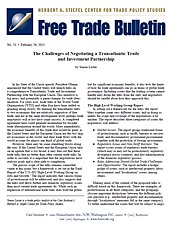This language indicates that the existing international investment rules in current U.S. and EU trade and investment agreements will be duplicated in any U.S.-EU agreement.
It is important to note a distinction between two types of investment policies. First, there are policies related to investment liberalization. At its core, liberalization of foreign investment suggests that countries will not discriminate against foreign investors as compared to domestic investors. That means any barriers to an initial foreign investment would be limited to legitimate concerns such as national security; and it means that once a foreign investment has been made, governments will treat domestic and foreign companies the same.
By contrast, investment protection is a broader concept. Protection of domestic companies who invest abroad can go beyond simple nondiscrimination. For example, typical international investment rules set out a “minimum standard of treatment,” under which foreign investors are entitled to a certain level of good treatment, and can sue even where the host government’s actions are nondiscriminatory. When combined with the ability of foreign investors to sue governments directly (referred to as investor-state arbitration), these rules have been controversial.
Cross-border flows of investment between the United States and the European Union are quite large. As the report notes, “the United States and the European Union have directly invested more than $3.7 trillion/€ 2.8 trillion on both sides of the Atlantic.” All of this investment is beneficial in economic terms. However, it also provides numerous opportunities for investor-state litigation, which may cause concern among groups who worry that these rules interfere with domestic policy autonomy. Under the similar provisions of the North American Free Trade Agreement (NAFTA), Canadian companies have brought 15 cases against the United States in the almost 20 years since the NAFTA was signed.2 With EU investment in the United States over seven times the amount of Canadian investment,3 there is the potential for a large number of complaints.
Regulatory Issues
One of the most difficult issues in these negotiations is how to address various concerns about domestic regulation. There are a number of issues within this general category: Regulation as a trade barrier, international regulatory cooperation, and regulatory practices.
At the outset, it is worth noting that issues of regulatory protectionism are already dealt with under the rules of the WTO. There is a long history of WTO cases—and prior to the WTO, at the General Agreement on Tariffs and Trade (GATT)—dealing with protectionism applied through regulatory measures. Although the report is not completely clear on this point, presumably the United States and the European Union will continue to rely on the WTO to deal with such issues and are not seeking to rewrite the WTO’s jurisprudence.
However, regulations can act as trade barriers even if they are not protectionist. The WTO’s rules deal with this issue as well, but it appears that the United States and the European Union are seeking to push the rules further. In this regard, two of the specific proposals are
- An ambitious “SPS-plus” chapter, including establishing an ongoing mechanism for improved dialogue and cooperation on addressing bilateral sanitary and phytosanitary (SPS) issues. The chapter will seek to build upon the key principles of the World Trade Organization (WTO) SPS Agreement, including the requirements that each side’s SPS measures be based on science and on international standards or scientific risk assessments, applied only to the extent necessary to protect human, animal, or plant life or health, and developed in a transparent manner, without undue delay.
- An ambitious “TBT-plus” chapter, building on horizontal disciplines in the WTO Agreement on Technical Barriers to Trade (TBT), including establishing an ongoing mechanism for improved dialogue and cooperation for addressing bilateral TBT issues. The objectives of the chapter would be to yield greater openness, transparency, and convergence in regulatory approaches and requirements and related standards-development processes, as well as, inter alia, to reduce redundant and burdensome testing and certification requirements, promote confidence in our respective conformity assessment bodies, and enhance cooperation on conformity assessment and standardization issues globally.
In seeking to expand on both the SPS and TBT agreements, the United States and the European Union seem to be suggesting that the existing rules are inadequate. It is not clear why they think so. There have been a number of WTO disputes under these agreements already. These cases have delved into some very sensitive domestic regulatory issues, and have done so in a way that tries to balance trade issues and domestic policy concerns. WTO disputes between the United States and the European Union have addressed issues such as EU measures related to hormone treated beef and genetically modified organisms. But these disputes have shown how difficult these issues are to resolve. While the United States succeeded on its legal claims, domestic political constraints have prevented the European Union from complying. Perhaps there is room for improvement in the rules here, but without further details, it is difficult to say whether this particular proposal is a sensible one and what its impact might be.
With regard to regulatory cooperation, the report refers to “more compatible regulations for goods and services,” and further talks about


